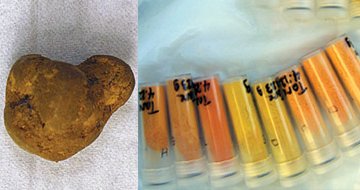
Uranium
Uranium General
| Name:Uranium | Symbol:U |
| Type:Rare Earth, Actinides | Atomic weight:238.029 |
| Density @ 293 K:18.9 g/cm3 | Atomic volume:12.59 cm3/mol |
|
Discovered:
In ancient times uranium oxide was used to produce yellow colored ceramic glazes. Uranium was formally discovered in 1789 by Martin Heinrich Klaproth. Klaproth was studying the mineral pitchblende, which was then believed to be a zinc/iron ore. Klaproth dissolved pitchblende in nitric acid, then added potash to obtain a yellow precipitate. Adding excess potash dissolved the yellow precipitate. Such reactions were not characteristic of any known element and Klaproth concluded he had discovered a new element. (1) He named it after the recently discovered planet Uranus. In 1841, Eugene-Melchior Peligot isolated uranium metal by heating uranium tetrachloride with potassium. |
|
Uranium States
| State (s, l, g):solid | |
| Melting point:1408 K (1135 °C) | Boiling point:4403 K (4130 °C) |
Uranium Energies
| Specific heat capacity:0.12 J g-1 K-1 | Heat of atomization:482 kJ mol-1 |
| Heat of fusion:8.520 kJ mol-1 | Heat of vaporization :422.58 kJ mol-1 |
| 1st ionization energy: 597.6 kJ mol-1 | 2nd ionization energy:1420 kJ mol-1 |
| 3rd ionization energy: kJ mol-1 | Electron affinity: kJ mol-1 |
Uranium Oxidation & Electrons
| Shells:2,8,18,32,21,9,2 | Electron configuration:[Rn] 5f3 6d1 7s2 |
| Minimum oxidation number:0 | Maximum oxidation number:6 |
| Min. common oxidation no.:0 | Max. common oxidation no.:6 |
| Electronegativity (Pauling Scale): | Polarizability volume:27.4 Å3 |
Uranium Appearance & Characteristics
| Structure:orthorhombic | Color:silvery-white |
| Hardness:6.0 mohs | |
|
Harmful effects:
Uranium is harmful both through its chemical toxicity and its radioactivity. Exposure to uranium increases your risk of getting a variety of cancers due to its radioactivity. |
|
|
Characteristics:
Uranium is a dense, silvery-white, slightly paramagnetic, radioactive metal. It is also ductile and malleable. The metal tarnishes in air acquiring a dark layer of oxide. When finely powdered, uranium ignites spontaneously in air. Uses: Uranium is used as fuel for nuclear power plants. One kilogram of uranium-235 has the capacity to produce as much energy as 1,500,000 kilograms (1,500 tonnes) of coal. |
|
Uranium Reactions
| Reaction with air:mild, ⇒ U3O8 | Reaction with 6 M HCl:mild, ⇒ H2 |
| Reaction with 15 M HNO3:passivated | Reaction with 6 M NaOH:mild, ⇒ none |
Uranium Compounds
| Oxide(s):UO, UO2, UO3 , U2O5, U3O8 , | Chloride(s):UCl, UCl3, UCl4, UCl5, UCl6 |
| Hydride(s): UH3 |
Uranium Radius
| Atomic radius:175 pm | Ionic radius (1+ ion):pm |
| Ionic radius (2+ ion):pm | Ionic radius (3+ ion):116.5 pm |
| Ionic radius (2- ion):pm | Ionic radius (1- ion):pm |
Uranium Conductivity
| Thermal conductivity:27.5 W m-1 K-1 | Electrical conductivity:3.6 x 10-6 S m-1 |
Uranium Abundance & Isotopes
| Abundance earth's crust:2.7 parts per million by weight, 0.25 parts per million by moles | |
| Abundance solar system:1 part per billion by weight, 4 parts per trillion by moles | |
| Cost, pure: $ per 100g | |
| Cost, bulk: $9 per 100g | |
|
Source:
Uranium occurs naturally in several minerals such as uraninite (uranium oxide), carnotite and autunite. Canada is the world's largest supplier of uranium, producing 20 to 30 percent of supplies. (2) Commercially, uranium is produced through the reduction of uranium halides with alkali earth metals. Although most people think uranium is extraordinarily rare, it is in fact more abundant than famil |
|
|
Isotopes:
Uranium has 21 isotopes whose half-lives are known, with mass numbers 218 to 242. Natural uranium consists of three major isotopes: 234U, 235U, and 238U. All are radioactive. 238U is the most stable isotope, with a half-life of 4.51 x 109 years (almost the age of the Earth). |
|
Uranium Other
|
Other:
|
|
Prev: Protactinium Next: Neptunium |